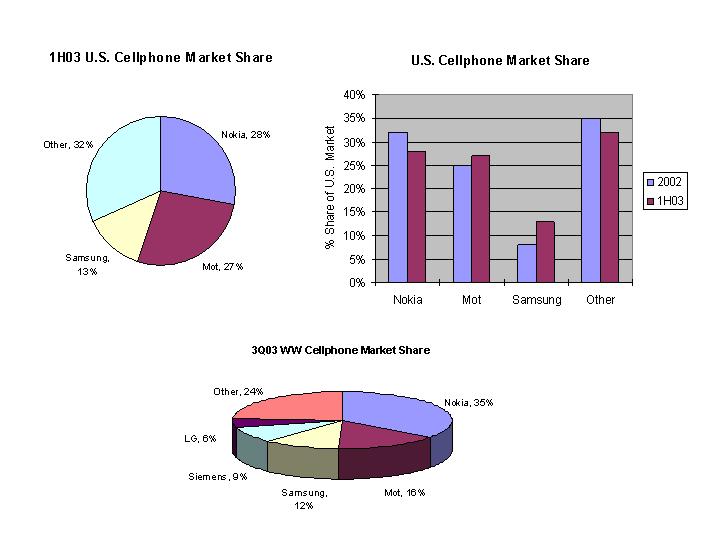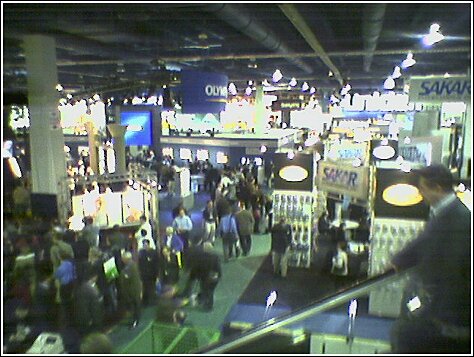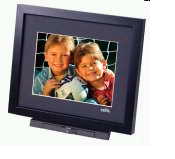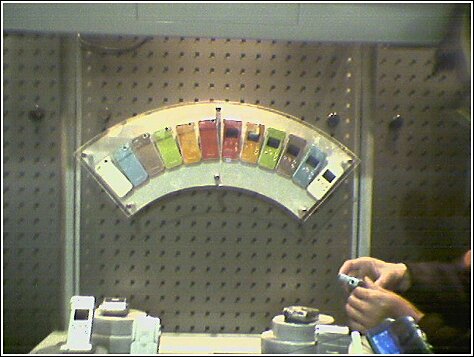Friday, February 20, 2004
 Hitting the Slopes
Hitting the SlopesI'm outta here until late next week. Snow has been dumping on Mammoth and I am going to check it out.
Thursday, February 19, 2004
Reader Questions - Cellphone Market Data
One of the services I am pleased to offer my readers is free consulting services (well, as long as it is an easy question or data I have ready access to, and doesn't create a conflict of interest with any of my current responsibilities). Long time reader David sends in the following question:
Where can I find data on what manufacturers own what % of the US handset market?
The underlying assumption I am making is what "free" data is available. There are a variety of market research companies such as Gartner, Instat and others that will provide you all sorts of data, but will charge thousands of dollars per report. There is nothing wrong with that - they have to make a living - but often marketing managers just need a few data points and not a whole report. In addition, many marketing managers have a problem getting funds from management for marketing reports ("Why do we need to buy this? This is your job!) and this is especially true in a start-up, which David happens to be in.
First, here is the most current data I have for handsets for the U.S. and WW market. The U.S. market is at the end of 1H03, so a little stale, but it probably hasn't changed more than a few percentage points, and I have provided a graph to show how the data changed from the end of 2002. The WW data is probably current. Quarterly numbers are usually released in the second month of the following quarter, so the 4Q03 numbers are either just released or coming out soon:

So, where do you find this (free) data?
1. Press Releases and Articles - The market research companies issue press releases and the like to generate interest in their reports (their form of marketing). Most of the tech journals and many of the business journals publish this data as a reader interest story ("Samsung Gains Ground on Nokia in U.S. Market"), so I found the U.S. market data in the Wall Street Journal and saved it. In addition, these press releases are also published on the research companies' web sites, which is where I found the WW market data and where I will likely get an update for the 4Q numbers.
2. Schmooze the Analyst - Another way to get the data: call up the analyst at the research company who specializes in the area you need, tell him who you are, and what specific data you need (if it is only a point or to). Usually in order to generate good will and cultivate a potential client, they will release a few small data points to whet your appetite. In addition, if you can provide him with some valuable market data that makes his job easier, they are often willing to do a data trade (I am currently working this angle with an analyst at a Japanese analyst company for data I need on that market). Of course, data acquired this way cannot be publicly disseminated like I have with the data above, which was released into the public domain by the research companies themselves. It is vitally important that if you create a relationship with an analyst that you keep his data - his livelihood - confidential.
3. Talk to the Vendors in This Market - If you go to Samsung's cellphone group, they will be proud to tell you what their market share is in the U.S. market, how they are gaining on Nokia, and will release all sorts of data on the market to the right people. Vendors use both internal data as well as data from the research companies, so it usually matches.
Wednesday, February 18, 2004
Home Officing Survey
I am in my second week as one of the growing legion of home workers (aka "telecommuters" and a few other phrases) and am finding I am missing just a few of the little things one enjoys in a "regular" office.
My new work laptop finally arrived and I spent more than half a day getting it to the point where I needed it: transferring files, adding software, getting it talking to my home network, which suddenly has problems of its own. It makes me miss the days of calling Joe over right before lunch, giving him a list my PC problems, and telling him to have it done by the time I got back.
I am also doing a lot of self-service HR things since the gals in the home office (HR is dominated by women across industries) keep emailing me and sending me links for stuff I have to do for benefits, taxes, and payroll.
Anyway, I calculated that three of my co-workers from a previous company are all home officing in the area and sent them the following questionnaire. If you are also a home worker, feel free to send your responses to director_mitch@yahoo.com and I will publish a summary of the results with commentary in two weeks (responses will not be listed with any name or email addresses, which will stay anonymous). I have added my own responses below:
1. How long have you been home officing?
Second Week
2. Do you like it compared to "real" officing? Which do you prefer?
So far so good. As long as I have a phone and email, I can work. No distractions of people coming by and disturbing me, etc. No wasteful meetings. I can blare music while I do email.
3. What do you wear to the "office"? (pajamas, sweats, biz casual, etc.)
Biz casual. I get up and get dressed just like I were going to a regular office unless I decide to work out in the morning, in which case I put on sweats.
4. Are you alone during work hours or are there others in the office? (spouse, kids, pets)
All alone.
5. How often do you visit the "home office" (in this case, "home office" meaning headquarters and not your real home office)
Twice a month.
6. What hours do you work? Do you work more or less than if you were in a real office?
I put in less contiguous hours during the work day, but I am "on call" pretty much 24/7, so overall I will end up working more than if I were in a real office.
7. Does your spouse/SO ask you to do things around the house since you are home, even though you are working?
Yep. I already had to remind her that I was working and not just sitting around watching TV.
8. Do you try to get more appointments and lunches outside the house in order to get more human interaction or try to get out of the house more?
Even though it is my second week, I think I will be scheduling more lunches with people. I used to run errands and the like during lunch, but now I will use it to interface with people.
9. Any distractions at home that you wouldn't have to worry about at work?
A close pantry is going to be a problem for me.
10. Any other comments or observations?
Pretty good gig if you can swing it. There is a sales office near by where I can go if I want to interface with work people in addition to the bi-monthly trips to HQ.
Why Is It Us vs. Them?
While working today I had Rush on, but he was interrupted by the Dean withdraw speech. The thing that really struck me about the speech is how much I - an ordinary working American who leans conservative - is so hated by the democratic party and by liberals in particular. The start of the speech was okay - thanking workers for the hard work everyone put in, etc. It was a typical, uninteresting withdraw speech.
Then came the second half, filled with hate-filled diatribes of how the country was "taken way" and how people "don't have a voice" and how conservatives should be lined up and shot (okay, that last one is made up, but he was heading that direction). I laughed out loud when he talked about "Bush's right-wing agenda" since - except for foreign policy and cutting taxes - there is nothing Bush has done that could be considered "right-wing". There has been little for moderates to complain about outside of these two areas.
I guess I was actually saddened by the speech. He said nothing positive. He didn't talk about moving forward with new ideas or plans. It was all about getting "them" (meaning me). It was about revenge. And I hope it was the reason that Dean was rejected by his own party.
Monday, February 16, 2004
PMA: Not Much To Report
As noted below, I attended the Photo Marketing Association tradeshow last Friday. While the show was very worthwhile for me (5 meetings), it didn't seem that interesting for the average consumer unless you are really into digital or film photography.

The show still focuses on the film photography industry, so a majority of floor space is still dedicated to that segment: minilabs, paper, chemicals, stuff for studios, frames, you name it. Even those companies that have both film and digital cameras seem to focus more on their film cameras for this show (since CES is the highlight for tech, this is probably why). I would say that less than less than 10% of the floor space was for to digital cameras, printers, monitors and other high-tech tools for digital imaging. Photographyblog has a complete listing of all the announcements, mainly focusing on digital imaging.
That being said, here are a few things I noticed in the digital imaging realm:
Digital Photo Receiver - I still don't get these gadgets, but I guess I'm not the target audience. These are essentially little monitors that hook up the internet and upload digital pictures, i.e. a digital picture frame. The pitch is that you can change the picture every day!, but that isn't a value proposition for me, especially at $150. They said grandparents out of state are the big audience. These things hook up to the internet via a phone line. When asked if they had a WIFI version, their reply was "Grandparents don't know what WIFI is," but admitted they had one on the drawing board (my guess is that there is a cost problem).

Digital Video - The video camera market seems to be fragmenting into two areas:
1. Low End - Little cameras smaller than a typical MP3 player were in several booths, but most notably the Panasonic booth. These record low quality video onto a memory card and usually do several other functions as well (voice recording, MP3 playback, etc.).

Probably not something to take on vacation, but fun for kids and the like. This sort of gadget goes into the whole (CAUTION: Overused Word Warning) convergence thing that is going on with portable devices. We have cellphones with cameras, PDAs that play music, MP3 players that play video games, etc. The theory is that one day we have a portable gadget that does everything well. My guess is that we will wait a long time.
2. High End - "Normal" digital camcorders were still a big thing at the show. The trends in this segment haven't really changed: more resolution, smaller size, and recording directly onto DVD. I keep thinking a solid state camcorder will be announced (other than the low end ones above), but that doesn't seem to be happening. As HDTV takes off, expect direct to HDTV format camcorders in the near future.
Digital Still Cameras - I didn't spend a lot of time looking at this segment, but there were no big announcements that caught my eye. The digital SLRs at the high end keep getting more and more impressive and if you have a big budget, I would recommend looking at these before you buy your next high-end film SLR. The consumer DSCs are getting higher resolution with prices continuing to decline. No-name brands were in everywhere in this space and I think the Japanese are going to have to abandon this segment at mass retailers.
So overall, nothing really big to report to the average reader, but a worthwhile business trip for me personally.



 I am a
I am a 
